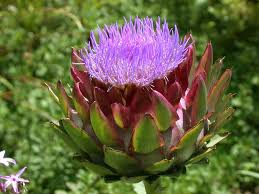 The globe artichoke (Cynara cardunculus var. scolymus) is a variety of a species of thistle cultivated as a food. The edible portion of the plant consists of the flower buds before the flowers come into bloom. The budding artichoke flower-head is a cluster of many budding small flowers (an inflorescence) together with many bracts, on an edible base. Once the buds bloom the structure changes to a coarse, barely edible form. The uncultivated or wild variety of the species is called a cardoon. It is aperennial plant native to the Mediterranean region.Artichokes can be produced from seeds or from vegetative means such as division, root cuttings or micropropagation. Though technically perennials that normally produce the edible flower only during the second and subsequent years, certain varieties of artichoke can be grown from seed as annuals, producing a limited harvest at the end of the first growing season, even in regions where the plants are not normally winter-hardy. This means home gardeners in northern regions can attempt to produce a crop without the need to overwinter plants with special treatment or protection. The recently introduced seed cultivar 'Imperial Star' has been bred to produce in the first year without such measures. An even newer cultivar, 'Northern Star', is said to be able to overwinter in more northerly climates, and readily survives subzero temperatures.Artichokes can also be made into an herbal tea. "Artichoke tea" is produced as a commercial product in the Da Lat region of Vietnam. The flower portion is put into water and consumed as an herbal tea, called alcachofa in Mexico. It has a slightly bitter woody taste.Artichoke is the primary flavor of the 33-proof (16.5%-alcohol) Italian liqueurCynar produced exclusively by the Campari Group. It can be served over ice as an aperitif or as a cocktail mixed with orange juice, especially popular in Switzerland. It is also used to make a 'Cin Cyn', a slightly less-bitter version of the Negroni cocktail, by substituting Cynar in place of Campari.
The globe artichoke (Cynara cardunculus var. scolymus) is a variety of a species of thistle cultivated as a food. The edible portion of the plant consists of the flower buds before the flowers come into bloom. The budding artichoke flower-head is a cluster of many budding small flowers (an inflorescence) together with many bracts, on an edible base. Once the buds bloom the structure changes to a coarse, barely edible form. The uncultivated or wild variety of the species is called a cardoon. It is aperennial plant native to the Mediterranean region.Artichokes can be produced from seeds or from vegetative means such as division, root cuttings or micropropagation. Though technically perennials that normally produce the edible flower only during the second and subsequent years, certain varieties of artichoke can be grown from seed as annuals, producing a limited harvest at the end of the first growing season, even in regions where the plants are not normally winter-hardy. This means home gardeners in northern regions can attempt to produce a crop without the need to overwinter plants with special treatment or protection. The recently introduced seed cultivar 'Imperial Star' has been bred to produce in the first year without such measures. An even newer cultivar, 'Northern Star', is said to be able to overwinter in more northerly climates, and readily survives subzero temperatures.Artichokes can also be made into an herbal tea. "Artichoke tea" is produced as a commercial product in the Da Lat region of Vietnam. The flower portion is put into water and consumed as an herbal tea, called alcachofa in Mexico. It has a slightly bitter woody taste.Artichoke is the primary flavor of the 33-proof (16.5%-alcohol) Italian liqueurCynar produced exclusively by the Campari Group. It can be served over ice as an aperitif or as a cocktail mixed with orange juice, especially popular in Switzerland. It is also used to make a 'Cin Cyn', a slightly less-bitter version of the Negroni cocktail, by substituting Cynar in place of Campari.
Medicinal Uses:The total antioxidant capacity of artichoke flower heads is one of the highest reported for vegetables.Cynarine is a chemical constituent in Cynara. The majority of the cynarine found in artichoke is located in the pulp of the leaves, though dried leaves and stems of artichoke also contain it. It inhibits taste receptors, making water (and other foods and drinks) seem sweet.
Studies have shown artichoke to aid digestion, hepatic and gall bladder function,and raise the ratio of HDL toLDL. This reduces cholesterol levels, which diminishes the risk for arteriosclerosis and coronary heart disease.Aqueous extracts from artichoke leaves have also been shown to reduce cholesterol by inhibiting HMG-CoA reductaseand having a hypolipidemic influence, lowering blood cholesterol. Artichoke contains the bioactive agents apigenin andluteolin. C. scolymus also seems to have a bifidogenic effect on beneficial gut bacteria. Its effect in arrestingpathogenic bacteria may be attributed to the notable presence of phenolic compounds. Both are higher in the baby anzio artichoke (Cyrnara scolymus). Artichoke leaf extract has proved helpful for patients with functional dyspepsia, and may ameliorate symptoms of irritable bowel syndrome.
No comments:
Post a Comment